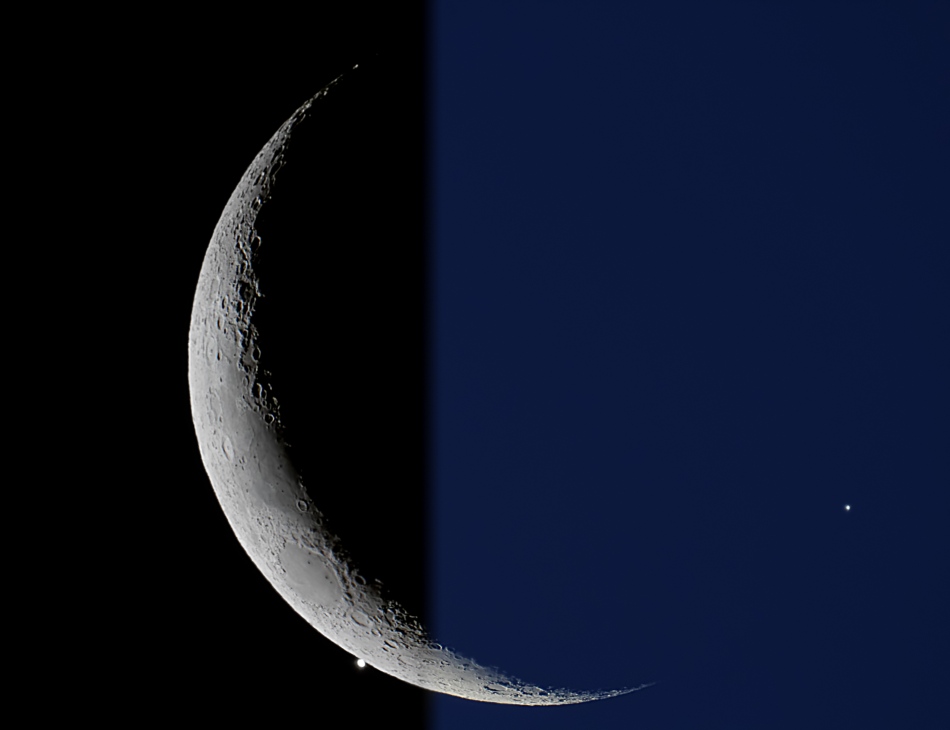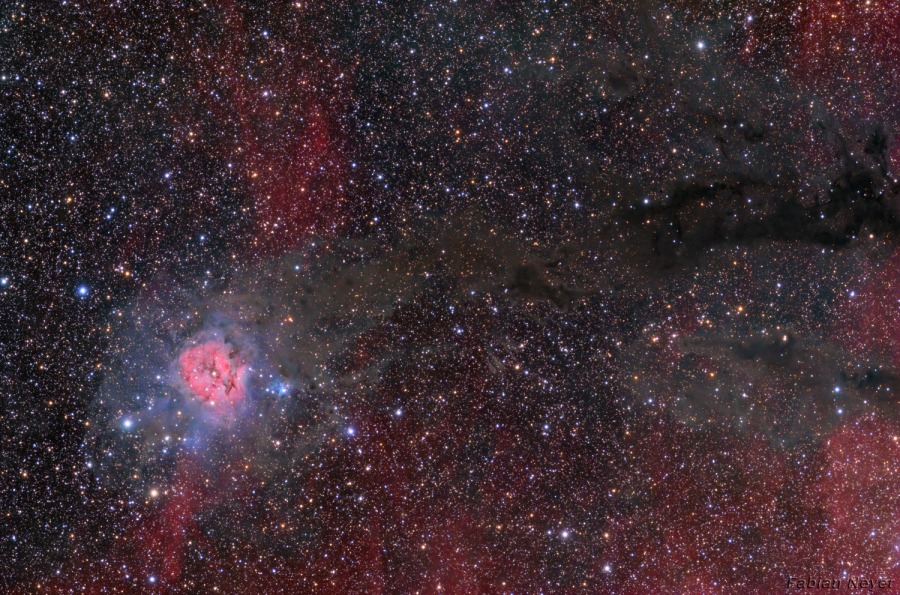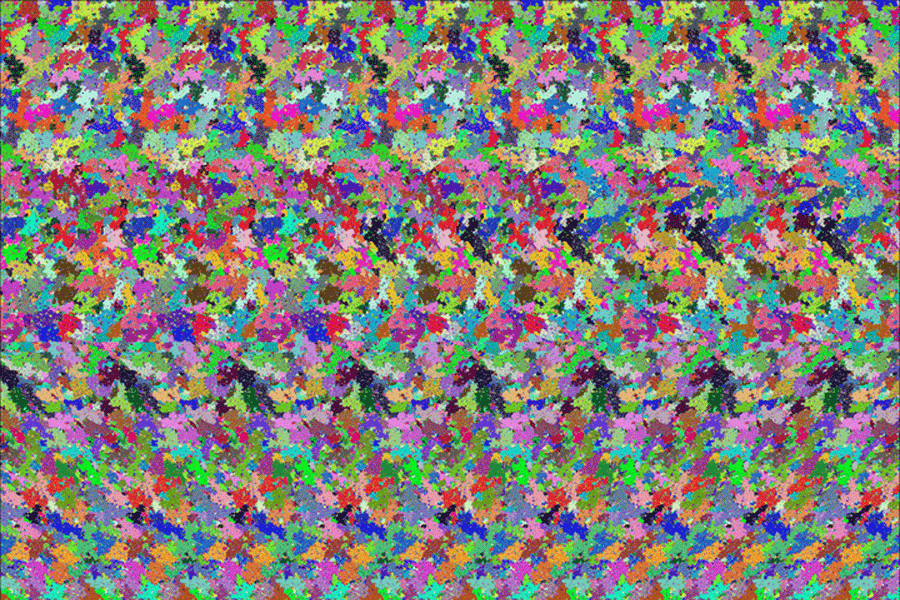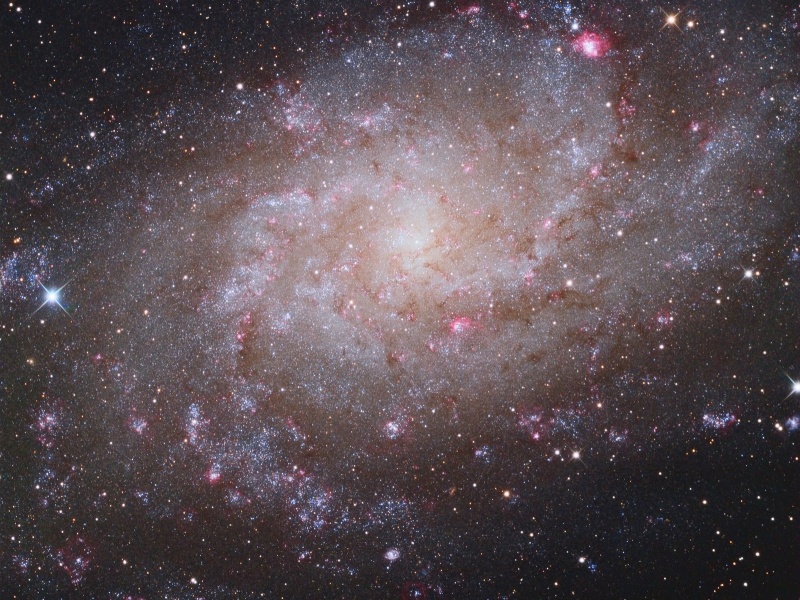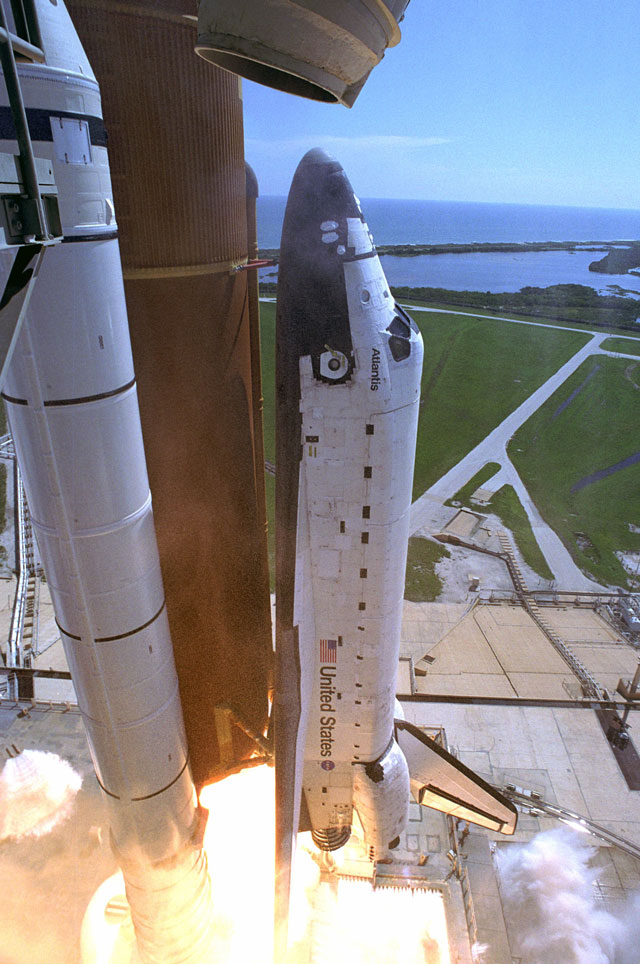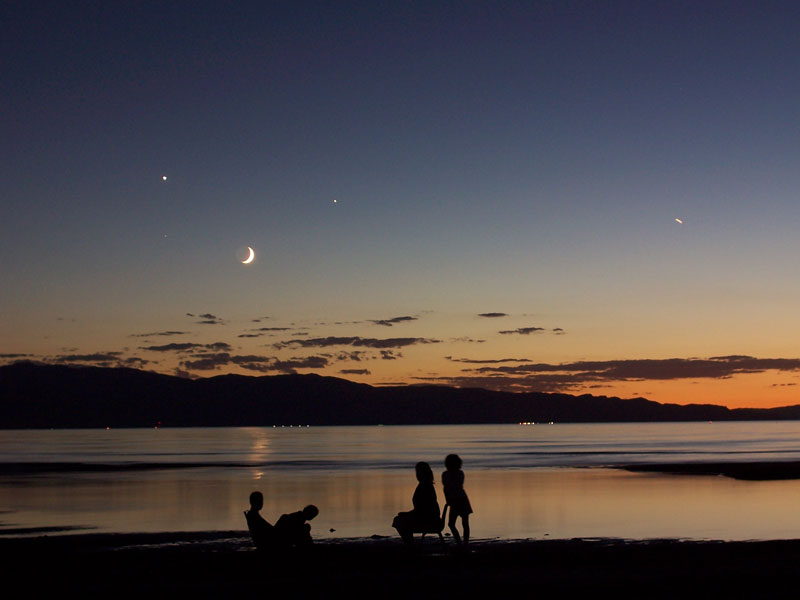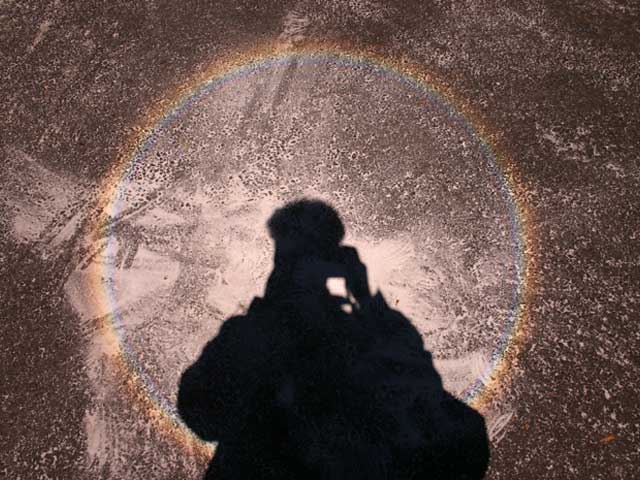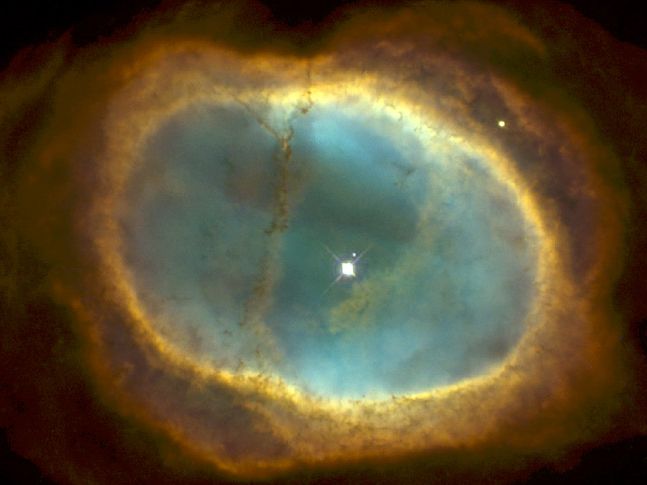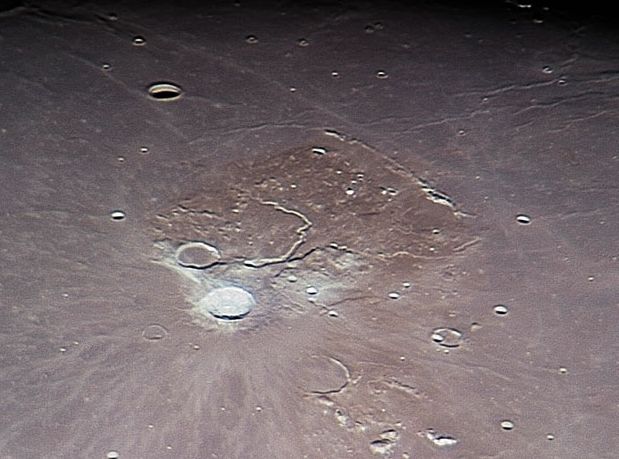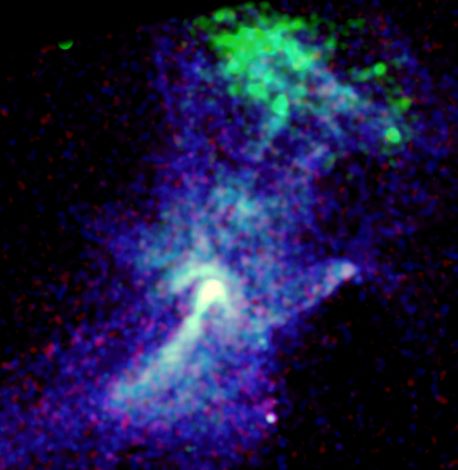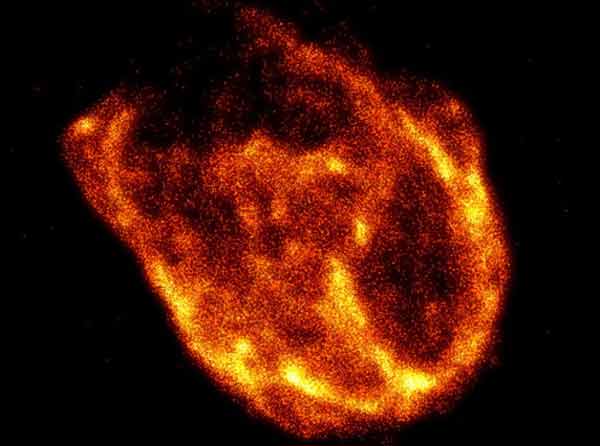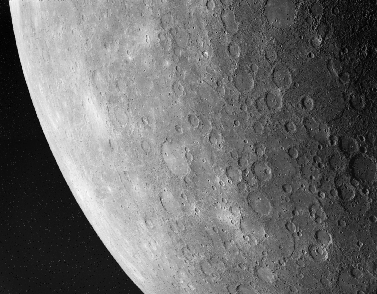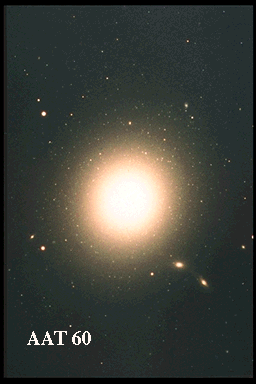| << Previous | Index | Next >> |
2015 It was a typical Texas sunset except that most of the Sun was missing. The location of the missing piece of the Sun was not a mystery -- it was behind the Moon. Featured here is one of the more interesting images taken of a partial solar eclipse that occurred in 2012, capturing a temporarily crescent Sun setting in a reddened sky behind brush and a windmill. The image was taken about 20 miles west of Sundown, Texas, USA, just after the ring of fire effect was broken by the Moon moving away from the center of the Sun. Today a new partial solar eclipse of the Sun will be visible from Earth. Unfortunately for people who live in Texas, today's eclipse can only be seen from southern Africa and Antarctica.
2014 Now, as you sip your cosmic latte you can view 100 Hubble Space Telescope images at the same time. The popular scenes of the cosmos as captured from low Earth orbit are all combined into this single digital presentation. To make it, Hubble's top 100 images were downloaded and resized to identical pixel dimensions. At each point the 100 pixel values were arranged from lowest to highest, and the middle or median value was chosen for the final image. The combined image results in a visual abstraction - light from across the Universe surrounded by darkness.
2013 On September 8, brilliant planet Venus appearing as the evening star stood near a slender, crescent Moon at sunset. The close celestial pairing or conjunction was a scene enjoyed by skygazers around the world. But from some locations in South America, the Moon actually passed in front of Venus in a lunar occultation. Captured near Las Cañas, Uruguay, this two frame mosaic telescopic view shows the Moon and Venus before and after the occultation. The silvery evening star appears at right just before it winked out behind the dark lunar limb, still in bright twilight skies. About an hour later Venus emerged (left) along the three day old Moon's sunlit edge.
2012 In this crowded starfield covering over 2 degrees within the high flying constellation Cygnus, the eye is drawn to the Cocoon Nebula. A compact star forming region, the cosmic Cocoon punctuates a long trail of obscuring interstellar dust clouds. Cataloged as IC 5146, the nebula is nearly 15 light-years wide, located some 4,000 light years away. Like other star forming regions, it stands out in red, glowing, hydrogen gas excited by the young, hot stars and blue, dust-reflected starlight at the edge of an otherwise invisible molecular cloud. In fact, the bright star near the center of this nebula is likely only a few hundred thousand years old, powering the nebular glow as it clears out a cavity in the molecular cloud's star forming dust and gas. But the long dusty filaments that appear dark in this visible light image are themselves hiding stars in the process of formation, seen at infrared wavelengths.
2011 The Great Nebula in Orion, also known as M42, is one of the most famous nebulas in the sky. The star forming region's glowing gas clouds and hot young stars are on the right in this sharp and colorful image that includes the smaller nebula M43 near center and dusty, bluish reflection nebulae NGC 1977 and friends on the left. Located at the edge of an otherwise invisible giant molecular cloud complex, these eye-catching nebulae represent only a small fraction of this galactic neighborhood's wealth of interstellar material. Within the well-studied stellar nursery, astronomers have also identified what appear to be numerous infant planetary systems. The gorgeous skyscape spans nearly two degrees or about 45 light-years at the Orion Nebula's estimated distance of 1,500 light-years.
2010
[imghover6=http://apod.nasa.gov/apod/image/1009/zo ... berger.jpg]http://apod.nasa.gov/apod/image/1009/zo ... otated.jpg[/imghover6]Credit & Copyright: Rudi Dobesberger (Sternfreunde Steyr)
2009 Is this picture worth a thousand words? According to the Holographic Principle, the most information you can get from this image is about 3 x 1065 bits for a normal sized computer monitor. The Holographic Principle, yet unproven, states that there is a maximum amount of information content held by regions adjacent to any surface. Therefore, counter-intuitively, the information content inside a room depends not on the volume of the room but on the area of the bounding walls. The principle derives from the idea that the Planck length, the length scale where quantum mechanics begins to dominate classical gravity, is one side of an area that can hold only about one bit of information. The limit was first postulated by physicist Gerard 't Hooft in 1993. It can arise from generalizations from seemingly distant speculation that the information held by a black hole is determined not by its enclosed volume but by the surface area of its event horizon. The term "holographic" arises from a hologram analogy where three-dimension images are created by projecting light though a flat screen. Beware, other people looking at the above image may not claim to see 3 x 1065 bits -- they might claim to see a teapot.
2008 The small, northern constellation Triangulum harbors this magnificent face-on spiral galaxy, M33. Its popular names include the Pinwheel Galaxy or just the Triangulum Galaxy. M33 is over 50,000 light-years in diameter, third largest in the Local Group of galaxies after the Andromeda Galaxy (M31), and our own Milky Way. About 3 million light-years from the Milky Way, M33 is itself thought to be a satellite of the Andromeda Galaxy and astronomers in these two galaxies would likely have spectacular views of each other's grand spiral star systems. As for the view from planet Earth, this sharp, detailed image nicely shows off M33's blue star clusters and pinkish star forming regions that trace the galaxy's loosely wound spiral arms. In fact, the cavernous NGC 604 is the brightest star forming region, seen here at about the 1 o'clock position from the galaxy center. Like M31, M33's population of well-measured variable stars have helped make this nearby spiral a cosmic yardstick for establishing the distance scale of the Universe.
2007 This alluring telescopic image looks toward the constellation Cepheus and an intriguing visual pairing of dusty reflection nebula NGC 7129 (left) and open star cluster NGC 7142. The two appear separated by only half a degree on the sky, but they actually lie at quite different distances. In the foreground, dusty nebula NGC 7129 is about 3,000 light-years distant, while open cluster NGC 7142 is likely over 6,000 light-years away. In fact, the pervasive and clumpy foreground dust clouds in this region redden the light from NGC 7142, complicating astronomical studies of the cluster. Still, NGC 7142 is thought to be an older open star cluster, while the bright stars embedded in NGC 7129 are perhaps a million years young. The telltale reddish crescent shapes around NGC 7129 are associated with energetic jets streaming away from newborn stars. Surprisingly, despite the dust, far off background galaxies can be seen in the colorful cosmic vista.
2006 Birds don't fly this high. Airplanes don't go this fast. The Statue of Liberty weighs less. No species other than human can even comprehend what is going on, nor could any human just a millennium ago. The launch of a rocket bound for space is an event that inspires awe and challenges description. Pictured above, the Space Shuttle Atlantis lifted off to visit the International Space Station during the morning of 2006 September 9. From a standing start, the two million kilogram rocket ship left to circle the Earth where the outside air is too thin to breathe and where there is little noticeable onboard gravity. Rockets bound for space are now launched from somewhere on Earth about once a week.
2005 This was a sky to show the kids. All in all, three children, three planets, the Moon, a star, an airplane and a mom were all captured in one image near Great Salt Lake in Utah, USA on September 6. Minus the airplane and the quadruple on the ground, this busy quadruple coincidence sky was visible last week all over the world. The easiest object to spot is the crescent Moon, which is easily the brightest sky orb in the above image. Venus is the highest planet in the sky, with Jupiter to its right. The bright star Spica completes the quadruple just below Venus. The streak on the far right is an airplane. Mom is seated. Grandpa, appreciating the beauty of the moment, took the picture.
2004 What caused this ring of colors? At the time of this writing, MIT Physics Professor Walter Lewin had yet to find someone who can give the correct explanation. Not students. Not colleagues. Not APOD editors. He wonders how the astute readers of APOD will do. Can you match wits with Professor Lewin? Lewin took the above picture in a construction area in Massachusetts on June 20. Your answer should be able to explain the color sequence and the bright area in the center. Shortly after he gives the explanation on December 7 during a lecture in his course Vibrations and Waves at MIT, APOD will carry a link to it. A discussion page for this image will be held in the APOD Forum on the Asterisk*. Additionally, Professor Lewin will answer appropriate e-mail questions and guesses sent to asklewin@space.mit.edu.
2003 It's the dim star, not the bright one, near the center of NGC 3132 that created this odd but beautiful planetary nebula. Nicknamed the Eight-Burst Nebula and the Southern Ring Nebula, the glowing gas originated in the outer layers of a star like our Sun. In this representative color picture, the hot blue pool of light seen surrounding this binary system is energized by the hot surface of the faint star. Although photographed to explore unusual symmetries, it's the asymmetries that help make this planetary nebula so intriguing. Neither the unusual shape of the surrounding cooler shell nor the structure and placements of the cool filamentary dust lanes running across NGC 3132 are well understood.
2002 Anchored in the vast lava flows of the Moon's Oceanus Procellarum lies the Aristarchus Plateau. Recorded from a backyard observatory on planet Earth, this sharp, amazingly colorful view nicely captures the geologically diverse area, including the brownish plateau, Aristarchus and Herodotus craters, and the meandering Vallis Schroteri. The bright impact crater at the corner of the plateau is Aristarchus, a young crater 42 kilometers wide and 3 kilometers deep, surrounded by a radial system of light-colored rays. Only slightly smaller, lava flooded Herodotus crater is above and to the left. A valley or rille feature likely carved by rapidly flowing lava or a collapsed lava tunnel, Vallis Schroteri begins just to the right of Herodotus and winds across the plateau for about 160 kilometers, eventually turning toward the top of the picture and the shadow of the lunar terminator. Aristarchus Plateau itself is like a rectangular island about 200 kilometers across, raised up to 2 kilometers or so above the smooth surface of the lunar Ocean of Storms.
2001 A bizarre stellar corpse 19,000 light-years from Earth, pulsar PSR B1509-58 beckons from the small southern constellation of Circinus. Like its cousin at the heart of the Crab nebula, the Circinus pulsar is a rapidly spinning, magnetized neutron star. Seen in this false-color Chandra Observatory image, the environment surrounding this cosmic powerhouse glows in high energy x-rays. The Circinus pulsar itself, thought to generate more than 7 quadrillion volts (7 followed by 15 zeros), lies within the knot of bright emission near the center of the picture. Stretching toward the bottom left, x-ray emission traces a jet of particles almost 20 light-years long that seems to arise from the pulsar's south pole, while the arc of bright emission above the central knot is likely a shockwave produced by particles driven from the pulsar's equator. Near the top of the picture, lower energy x-ray emission shown in green is from gas shock-heated to millions of degrees Celsius. The shocked gas was produced by debris blasted out from the stellar explosion that created the Circinus pulsar.
2000 Only last month the stage was set for Comet LINEAR (C/1999S4 LINEAR) to become the first "naked-eye" comet of Y2K. It didn't fill that role, of course, but it did turn in a very dramatic performance. Closely followed by astronomer Mark Kidger and colleagues with the Isaac Newton Group telescopes (La Palma, Canary Islands), comet LINEAR's nucleus apparently fragmented extensively on the night of July 25th. A faint fluorescent cloud fading against a background of stars is all that is still visible in this August 21st telescopic view from Loomberah, NSW Australia. Why did comet LINEAR break up? Comets are conglomerates of ice and rock. A very plausible scenario is that a substantial fraction of LINEAR's icy component was evaporated, leaving too little to hold the rocky material together. In any event, no bright telltale condensations remain. So, following its first tour through the inner Solar System, an encore from comet LINEAR seems unlikely!
1999 Thousands of years after a star explodes, an expanding remnant may still glow brightly. Such is the case with N132D, a supernova remnant located in the neighboring Large Magellanic Cloud galaxy. The expanding shell from this explosion now spans 80 light-years and has swept up about 600 Suns worth of mass. The bright regions surrounding the lower right of this X-ray image result from a collision with an even more massive molecular cloud. Towards the upper left, the supernova remnant expands more rapidly into less dense region of space. This image is one of the first ever taken with the High Resolution Camera onboard the orbiting Chandra X-ray Observatory, and records details being analyzed for the first time.
1998 Galileo Galilei made a good discovery great. Upon hearing at age 40 that a Dutch optician had invented a glass that made distant objects appear larger, Galileo crafted his own telescope and turned it toward the sky. Galileo quickly discovered that our Moon had craters, that Jupiter had its own moons, that the Sun has spots, and that Venus has phases like our Moon. Galileo, who lived from 1564 to 1642, made many more discoveries. Galileo claimed that his observations only made sense if all the planets revolved around the Sun, as championed by Aristarchus and Copernicus, not the Earth, as was commonly believed then. The powerful Inquisition made Galileo publicly recant this conclusion, but today we know he was correct.
1997 Johannes Kepler used simple mathematics to describe how planets move. Kepler was an assistant to the most accurate astronomical observer of the time, Tycho Brahe. Kepler was able to use Brahe's data to show that planets move in ellipses around the Sun (Kepler's First Law), that planets move proportionally faster in their orbits when they are nearer the Sun (Kepler's Second Law), and that more distant planets take proportionally longer to orbit the Sun (Kepler's Third Law). Kepler lived from 1571 to 1630, during the time of discovery of the telescope. Kepler was one of the few vocal supporters of Galileo's discoveries and the Copernican system of planets orbiting the Sun instead of the Earth.
1996 The planet Mercury resembles a moon. Mercury's old surface is heavily cratered like many moons. Mercury is larger than most moons but smaller than Jupiter's moon Ganymede and Saturn's moon Titan. Mercury is much denser and more massive than any moon, though, because it is made mostly of iron. In fact, the Earth is the only planet more dense. A visitor to Mercury's surface would see some strange sights. Because Mercuryrotates exactly three times every two orbits around the Sun, and because Mercury's orbit is so elliptical, a visitor to Mercury might see the Sun rise, stop in the sky, go back toward the rising horizon, stop again, and then set quickly over the other horizon. From Earth, Mercury's proximity to the Sun cause it to be visible only for a short time just after sunset or just before sunrise.
1995
| << Previous | Index | Next >> |


